The morning routine is nearly the same every day. Demetri Balint rises early to begin the day overseeing a commercial cut flower business. His wife Viesia Konar follows shortly thereafter to open the door to her flower shop. Sometime during their busy day, the couple will meet and discuss the operation of their public gardens, a 10-acre collection and display of unique plants and flowers.
This busy regimen occurs in Philomath, Oregon, in the heart of the Willamette Valley. Only a two-hour drive from Portland, Greengable Gardens has been the collaboration of Demetri and Viesia since they purchased the property in the summer of 2002. Today, the gardens host upwards of 10,000 visitors annually, many of whom attend on-site weddings and other special events and holidays.
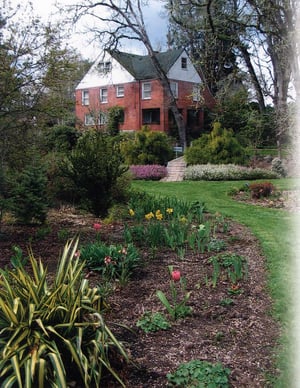 Storied Past
Storied Past
The history of Greengable Gardens dates back to 1930 when a local contractor purchased a large parcel of land on the outskirts of Philomath. He constructed a charming 20th century Norman-style farmhouse (now Demetri and Viesia’s home) to resemble the style of home the contractor’s wife remembered from her childhood in Denmark. Electricity was generated by a dam and power plant located on Greasy Creek that now meanders through the gardens.
In 1945, logger George Shroyer and his wife Helen purchased the property. While her husband built a considerable fortune in the logging business, Helen followed her passion for gardening by collecting thousands of plant species.
Recounting the gardens’ history, Demetri compares his wife’s enthusiasm for flowers and plants to that of Helen’s. George would come home for lunch and there would be a hot meal waiting from him, but no Helen. After several days of this, the logger’s curiosity got the best of him. One day, he decided to come home for lunch a bit earlier than usual, through a back entrance. Low and behold, he bumped into Helen on her way out to the gardens. That was her passion, and it truly is Viesia’s, as well.
Both Demetri and Viesia graduated from Oregon State University with degrees from the School of Agriculture. Demetri then spent 20 years as an agronomist, selling fertilizer and chemicals to area farmers. During that time, he also developed a hobby of growing and selling cut flowers. Viesia became a professional florist and owner of a flower shop in nearby Corvallis. The two met in 2000. Two years later they purchased 30 acres of the Shroyer estate, including the gardens.
“We were living comfortably at the time and didn’t need to take on a new mortgage and start a new life,” Demetri recalls. “Yet the gardens were spectacular, and continuing on with Helen’s legacy seemed to fit in perfectly with our penchant for nature and for growing plants.”
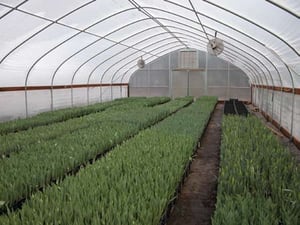 Over the last few years, the gardens have taken on the new owners’ personalities. There is a new flower shop for Viesia and new greenhouses to accommodate Demetri’s cut flower business (no longer a hobby). The display gardens have been expanded, too. Visitors can tour the gardens and cut flower commercial farm yearround, take flower arranging classes, and attend any of several festivals and special events held each year. They can also arrange to host their own private parties and gatherings.
Over the last few years, the gardens have taken on the new owners’ personalities. There is a new flower shop for Viesia and new greenhouses to accommodate Demetri’s cut flower business (no longer a hobby). The display gardens have been expanded, too. Visitors can tour the gardens and cut flower commercial farm yearround, take flower arranging classes, and attend any of several festivals and special events held each year. They can also arrange to host their own private parties and gatherings.
Living a Dream
“When you truly enjoy what you’re doing, it never seems like work,” says Demetri, noting that there is a lot of enjoyment to go around at Greengable Gardens. In his cut flower operation, he grows 3 million tulips and daffodils for shipment to retailers across the country. During the busy season, he employs up to 30 individuals who help with planting and growing bulbs and harvesting, packaging and sending off cut flowers.
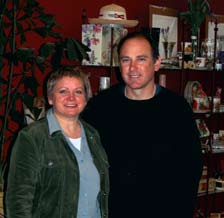 Viesia spends her time running the flower shop and tending to the gardens. “I think the biggest challenge in the garden is weeding,” she says with a smile. “Don’t get me wrong. I enjoy the gardens, but the weeding and pruning can become overwhelming at times.”
Viesia spends her time running the flower shop and tending to the gardens. “I think the biggest challenge in the garden is weeding,” she says with a smile. “Don’t get me wrong. I enjoy the gardens, but the weeding and pruning can become overwhelming at times.”
She adds quickly, “Demetri helps, of course, and he is responsible for keeping the lawn area mowed and trimmed for guests.”
She looks at her husband and says, “Tell the gentleman about how the gardens were maintained before we arrived.” He nods and then relates how the previous owners mowed the two to three acres of turf with a 20-inch walk-behind mower. “It took them up to 18 hours to mow the gardens. We cut the time more than in half with a Kubota mower, but it was difficult getting the large machine up the small paths and around the trees. Furthermore, we bag all the clippings, and the Kubota just wasn’t that well-suited for the task. Two years ago, I saw a Walker Mower at a trade show and thought it would be ideal for our operation. It was small and maneuverable and it had a great grass-handling system.”
Demetri purchased a 26-hp Walker Mower equipped with a 48-inch GHS deck. He added a wood chipper attachment to his order to help dispatch a constant onslaught of twigs and branches.
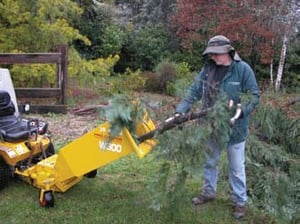 “We used to collect and burn the branches,” he explains. “Now, we run 80 percent of them through the Walker chipper and spread the chips for mulch. We can take the chipper virtually any place in the gardens and two baskets in the hopper allow us to easily spread the chips.”
“We used to collect and burn the branches,” he explains. “Now, we run 80 percent of them through the Walker chipper and spread the chips for mulch. We can take the chipper virtually any place in the gardens and two baskets in the hopper allow us to easily spread the chips.”
As for the mower, he says it has made his life easy and less complex. What took the previous owner 18 hours and Demetri five hours to mow with his Kubota, now takes him two to three hours with his Walker. Clippings are dumped in a nearby compost pile, again for use in the gardens.
This is the gardens’ second summer with the Walker. After two full seasons, the mower has logged 200 hours, mowing once a week during the growing season and once a month during the short winters.
“We usually mow on Thursdays to make sure the grounds are in perfect shape for weekend visitors and wedding parties,” Demetri explains. “People like to see the nice patterned look that the Walker leaves behind. There’s something about the vacuum action of the deck that lifts the grass blades and leaves the turf looking neat and clean.”
Being an agronomist and being around farmers virtually his entire adult life, he says he also appreciates the Walker Mower quality. “The only problems I have had were selfinflicted. I hit a tree stump only after 20 hours of operation and bent the deck and destroyed a gear box. I’ve also knocked down a few irrigation pipes with the hopper. I had to get used to the way the hopper swings around when I make a sharp turn.”
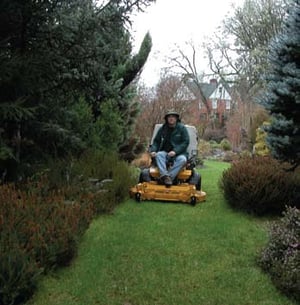 But the operator is very comfortable with his machine now, and looks forward to his time mowing the gardens. In fact, he and Viesia look forward to all the chores as they grow their growing business. Weddings and tours pay for the upkeep and expansion of the gardens, the flower shop business is blooming, and the cut flower operation is continually expanding.
But the operator is very comfortable with his machine now, and looks forward to his time mowing the gardens. In fact, he and Viesia look forward to all the chores as they grow their growing business. Weddings and tours pay for the upkeep and expansion of the gardens, the flower shop business is blooming, and the cut flower operation is continually expanding.
“When I first started with cut flowers, I sold them from a small flower stand,” Demetri remembers. “Now we grow 16 acres of tulips. Our cut flower business is small compared to larger factory farms, but we are very busy. One of our goals is to continue to grow all three operations to be able to offer employees more benefits. We also want to continue the legacy of the property’s previous owners and gradually add more display gardens and unique flowers for everyone to enjoy.”
As he points out, the 30 acres they purchased four years ago could have been subdivided into two-acre parcels. Instead, they’re preserving the past while building for the future.
Greengable Gardens is open for viewing year-round, daily from 10 a.m. to 6 p.m. For a closer look at the beautiful gardens and a calendar of upcoming events, please visit www.greengable.com.




 Site Search
Site Search



